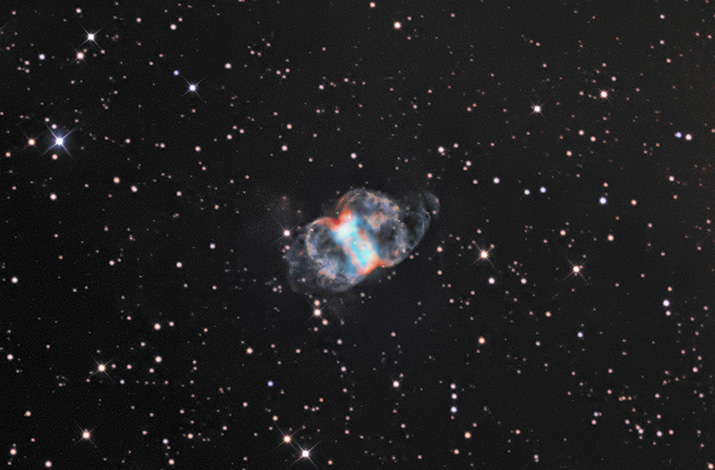
|
Date: Noveber 1 thru 6, 2014 Location: Denton, TX Telescope: ATRC12 Camera: ST-10XME - Guided using Inovations Foresight ONAG Exposure: Ha = 7 hr. OIII = 8 hr. (Bin 1x1 - 30 min. Sub-Exposures) Image for Stars: R = 25min G & B = 30 min each (Bin 2x2 - 5 min. Sub-Exposures) Click on the image to view at higher resolution |

|
Discovered by Pierre Méchain in 1780. Lying approximately 3,900 light-years from the Earth in the constellation Perseus, M76, also known as the Little Dumbbell or Butterfly Nebula, is a prime example of a bipolar planetary nebula. Planetary nebula are formed when Sun like stars run out of fusible fuel and eject their outer layers leaving only their hot collapsed cores. In the early stages of this "dying" process, the star enters the red giant phase and swells to enormous size. During this phase, a very strong stellar wind developes and ejects considerable amounts of material from the stars outer atmosphere. As the star continues to burn fuel, primarily helium, the stellar wind becomes much stronger and is ejected at a greater velocity. As this stronger wind collides with the slower, previously ejected, gas, a shock front is formed. The final stage of this process occurs when the helium fuel has been exhausted and the core collapses. In this process the remainder of the stars atmosphere is violently ejected to form the final planetary nebula structure. M76 very clearly shows this process. Three distinct zones can readily be seen progressing outward form the center of the nebula. These zones are like a time lapsed image of the death of the progenitor star with the faint outer portions being the oldest. The "butterfly wings" are the shock fronts generated in the latter stages of the red giant phase and the bright central cylinder was formed when the core collapsed. The above narrowband image was assembled using Ha and OIII filtered data. A bi-color palette was used with Ha data mapped to Red and OIII data was mapped to Green and Blue. Stars were overlaid with RGB data from a separate image. 1http://www.robgendlerastropics.com/M76text.html
|